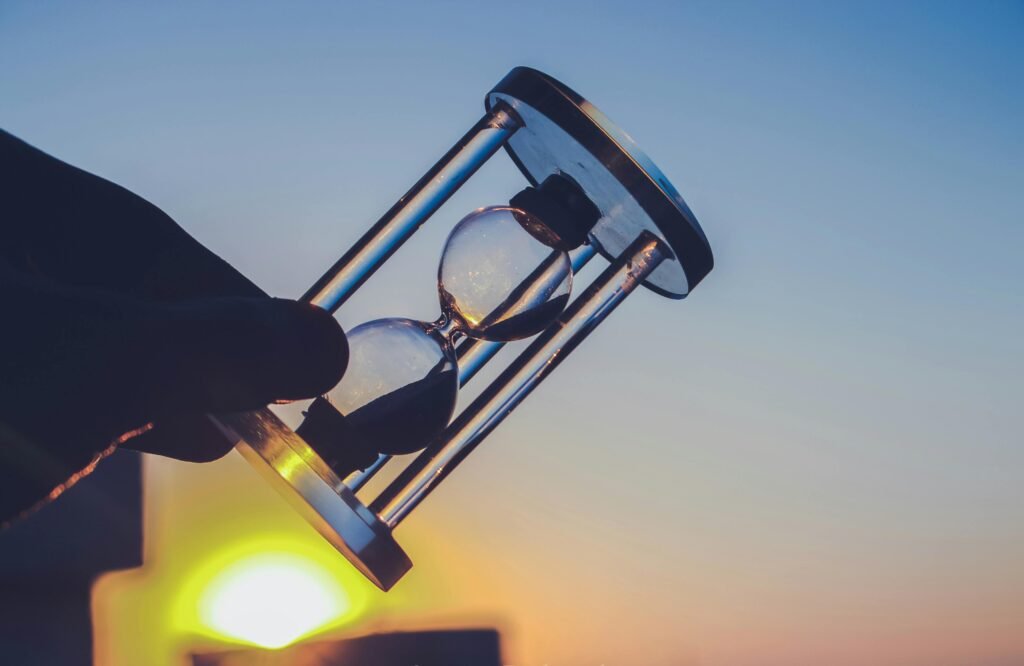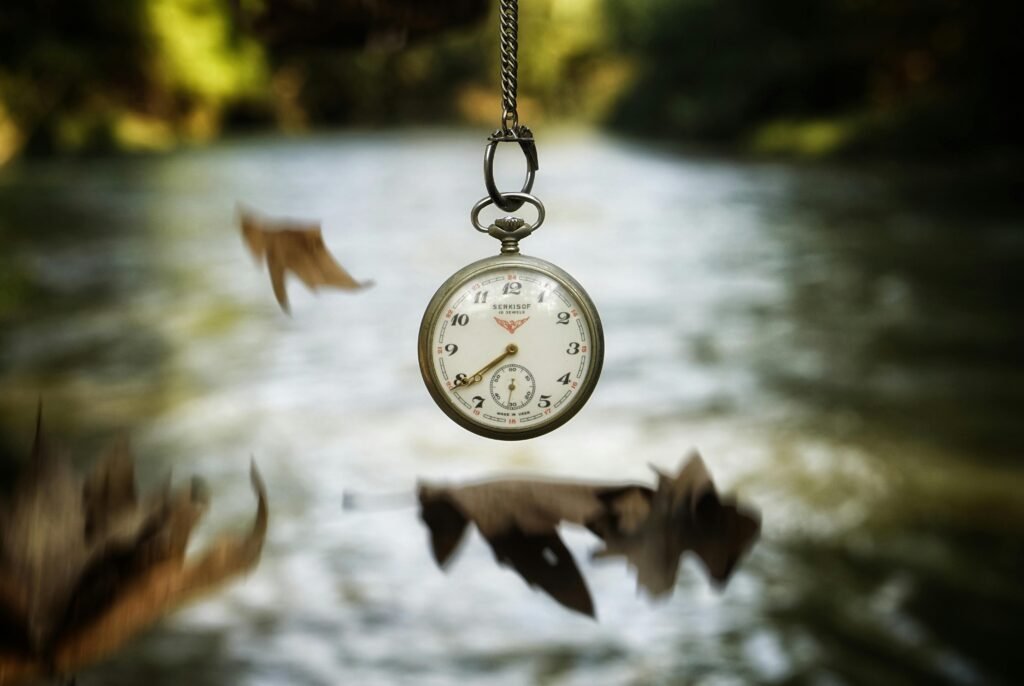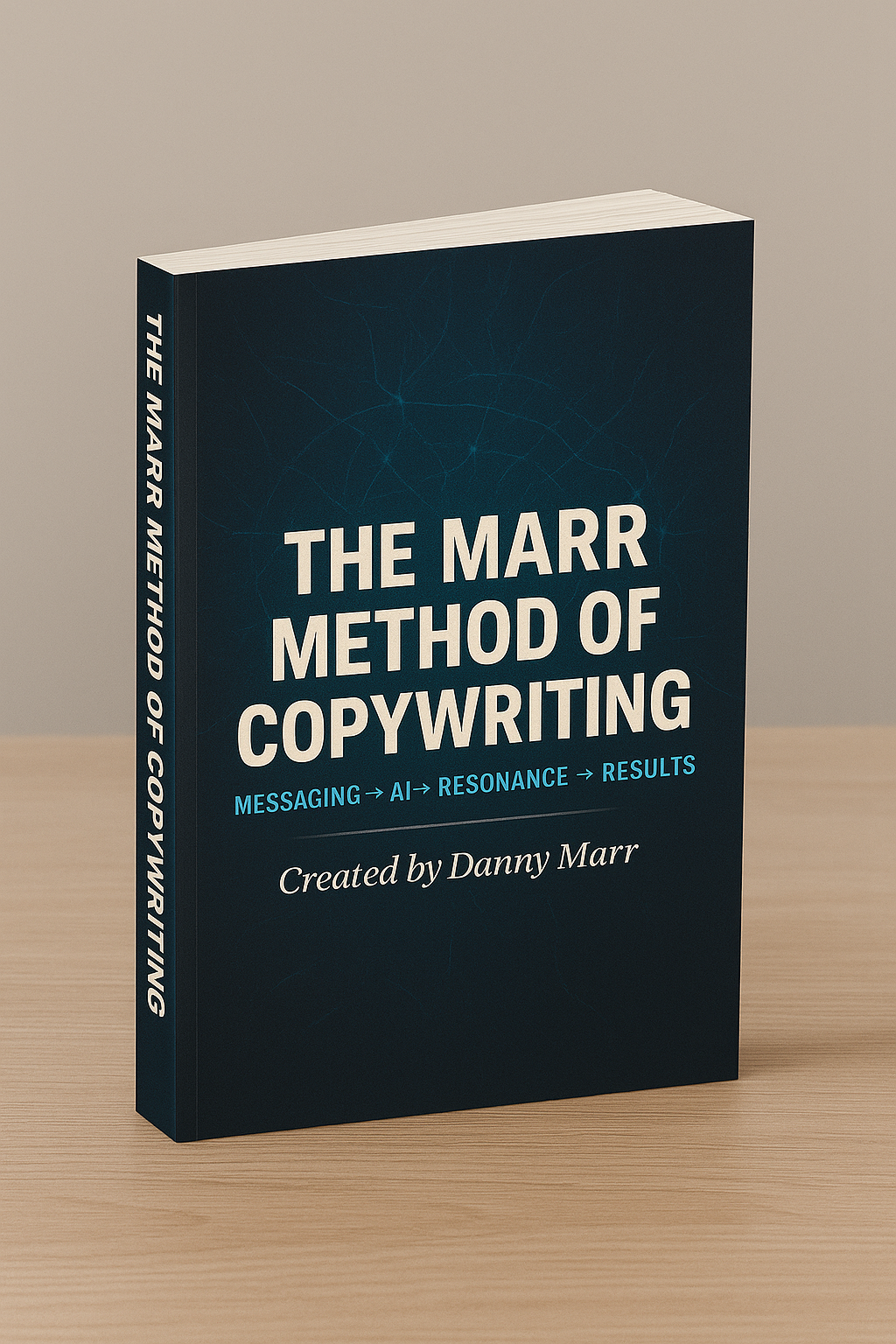
Understanding Time in Poetry
Time is an ever-present force, weaving through every poem with its invisible threads.
In poetry, time becomes more than just minutes ticking away; it transforms into a profound element that shapes narratives and emotions.
Recognizing time as both linear and cyclical allows poets to create pieces that resonate deeply with the reader’s own sense of life’s ebb and flow.
In a poem, time can unfold in myriad ways.
It can be a silent observer, witnessing the joys and sorrows of life.
Or it can be an active participant, propelling events forward or dragging them out interminably.
To harness the essence of time, poets often rely on symbolic language, capturing the intangible through vivid imagery and powerful symbols.
Imagine a clock, not just as a device that measures hours, but as a symbol of life’s constant forward movement.
Or consider the changing seasons: winter giving way to spring represents renewal and hope, while autumn’s falling leaves evoke endings and transitions.
These symbols help to express the nuances of time’s passage without overtly stating it, engaging readers on a deeper, more intuitive level.
Rhythm and meter also play a crucial role in portraying time.
The rhythm of a poem can mimic the steady tick of a clock or the irregular beat of a heart in moments of anxiety.
By manipulating rhythm, poets can convey different experiences of time—whether it’s the slow, languid stretch of a summer afternoon or the frantic rush of a moment slipping away.
The interplay of long and short lines, varied pacing, and strategic pauses all contribute to the poem’s temporal landscape.
Metaphors are another powerful tool in the poet’s arsenal.
They allow for a richer, more layered interpretation of time.
Time can be likened to a river, constantly flowing and never returning to the same spot.
It can be a relentless tide, washing away the footprints of the past.
Or it can be a winding road, with each turn revealing a new vista or challenge.
These metaphors invite readers to ponder their own relationship with time, making the experience of reading the poem deeply personal.
When writing about time, it’s also essential to consider its emotional weight.
Time can bring both solace and sorrow. It heals wounds, but it also erases memories.
It offers opportunities for growth, yet it also marks the relentless march toward the inevitable.
By exploring these emotional dimensions, poets can create works that are not only intellectually engaging but also emotionally resonant.
The interplay of time and memory is another rich vein to explore in poetry.
Memories are fragments of the past, preserved in the amber of our minds.
They defy the linear progression of time, allowing us to revisit moments long gone.
This temporal duality—the coexistence of past and present within the mind—can be a powerful theme in poetry.
It allows for a deeper exploration of how we experience time not just as a sequence of events, but as a complex tapestry of lived experiences.
Ultimately, understanding time in poetry involves embracing its dual nature: the relentless forward march and the cyclical return.
It’s about capturing the subtle ways time influences our lives and emotions.
Through symbolic language, rhythmic structure, and evocative metaphors, poets can transform the abstract concept of time into something tangible and deeply felt, enriching the reader’s experience and offering a unique lens through which to view their own passage through life.
Symbolic Language and Imagery

In poetry, symbolic language and imagery provide a profound avenue for expressing the passage of time.
Symbols like clocks, seasons, or the sun rising and setting can convey the flow of time without overt declarations.
Consider how the image of an hourglass, with sand trickling from top to bottom, serves as a poignant visual metaphor for time’s steady march.
Each grain represents a moment, slipping away yet contributing to the whole.
Seasons offer another rich palette for symbolizing time.
The transition from winter’s chill to the renewal of spring can embody themes of rebirth and the cyclic nature of existence.
Autumn, with its vibrant leaves turning and eventually falling, can symbolize decay and the closing of a chapter.
These natural cycles provide a relatable and visually compelling way to capture the passage of time in poetry.
Imagery that evokes time can also be found in the gradual changes that occur in everyday life.
The fading of colors on a cherished photograph, the wear and tear on a beloved object, or the shifting shadows over the course of a day—all these elements can symbolize the inexorable flow of time.
A slowly rusting gate might evoke the passage of years, while a clock tower striking midnight could signal a moment of change or transition.
Another powerful example is the image of a river, a metaphor often used to represent time’s unceasing flow.
Imagine the river’s current, which never pauses and never returns to the same point.
This relentless movement can symbolize how time carries us forward, washing away the past and propelling us into the future.
Just as the river shapes the landscape through which it flows, time shapes our experiences and memories.
The interplay of light and shadow is another evocative tool in representing time.
Consider how the changing position of the sun casts different shadows throughout the day, marking the passage of hours.
The soft light of dawn can symbolize beginnings and potential, while the golden hues of sunset often evoke reflection and closure.
These shifts in light can mirror the emotional tones we associate with different times of day or stages of life.
In crafting poetry, the selection of symbolic language and imagery should resonate deeply with the themes being explored.
A poet might use the image of a clock, not just to mark the hours, but to suggest the relentless ticking away of life’s moments.
Or, they might evoke the cyclical nature of time through the metaphor of a spinning wheel, continually turning yet always returning to a starting point.
The seasons, too, can be mined for rich imagery.
The budding flowers of spring can symbolize new beginnings and hope, while the stark barrenness of winter might evoke themes of loss or dormancy.
Summer’s long, languid days can suggest a carefree passage of time, contrasting with the brisk, shortening days of autumn that signal impending change.
Imagery grounded in the natural world provides a universally understood vocabulary for discussing time.
Whether it’s the steady erosion of a coastline by the sea or the fleeting beauty of a blooming flower, these images tap into the reader’s innate understanding of time’s effects.
They allow poets to communicate complex concepts in an accessible and emotionally resonant way.
Ultimately, the use of symbolic language and imagery in poetry serves to deepen the reader’s engagement with the theme of time.
By choosing symbols that are rich with meaning and layering them with evocative imagery, poets can create works that not only capture the essence of time but also invite readers to reflect on their own experiences with its passage.
Rhythm and Meter in Capturing Time

Rhythm and meter are the heartbeat of poetry, echoing the steady pulse of time.
Just as each tick of a clock measures a second, the cadence of a poem can mirror the passage of moments.
Poets often harness this rhythmic quality to evoke the sensation of time slipping through our fingers or stretching languidly before us.
Consider the impact of a steady, unchanging meter.
A poem written in consistent iambic pentameter, for example, can evoke the relentless, unyielding march of time.
The regular beat mimics the steady progression of hours and days, creating a sense of continuity and persistence.
This rhythmic pattern can be particularly effective in conveying the inevitability of time’s advance, much like the never-ending swing of a pendulum.
In contrast, poets can use variations in rhythm and meter to capture the more erratic and unpredictable nature of time.
Short, staccato lines can evoke the hurried pace of a fleeting moment or the rush of an urgent event.
Conversely, long, flowing lines might convey the slow, almost dreamlike quality of a lazy afternoon.
By playing with the length and rhythm of lines, poets can simulate the diverse tempos at which time seems to pass, reflecting its mutable nature.
The strategic use of pauses and breaks within a poem also serves to underscore the passage of time.
Enjambment, where a sentence or phrase runs over from one line to the next without a terminal punctuation mark, can create a sense of continuity and flow, much like the seamless transition from one moment to the next.
Meanwhile, a sudden break or caesura—a pause in the middle of a line—can create a moment of stillness, a brief suspension of time that invites the reader to linger.
Metaphorically, rhythm can embody the cyclical nature of time.
The repetition of sounds or patterns within a poem can mirror the cycles of days, seasons, and life itself.
A refrain that returns at regular intervals might symbolize the recurrence of certain events or emotions, much like the phases of the moon or the changing seasons.
For example, a poem that alternates between fast and slow tempos might reflect the contrasting experiences of time in different contexts.
The hurried, breathless pace of a city can be juxtaposed with the tranquil, measured rhythm of rural life.
This contrast can highlight the subjective experience of time, showing how it can be both a relentless force and a gentle flow, depending on our perspective.
Additionally, rhythm can evoke the emotional undertones of time.
A mournful, dirge-like cadence might convey the sorrow of time lost, while a lively, upbeat rhythm could capture the joy of a moment fully lived.
By aligning the poem’s rhythm with its emotional content, poets can deepen the reader’s engagement with the theme of time, making it felt as well as understood.
In essence, rhythm and meter are not just technical aspects of poetry; they are powerful tools that can bring the abstract concept of time to life.
By carefully crafting the rhythm and meter, poets can create a temporal landscape that resonates with the reader, capturing the complex and multifaceted experience of time in a profoundly evocative way.
Using Metaphor to Describe Time

Time is an elusive and intricate concept that gains richness when expressed through metaphor.
By drawing on vivid and relatable images, poets can unlock new layers of meaning and invite readers to see time in a fresh light.
Consider time as a river, continuously flowing and shaping the landscape through which it passes.
This metaphor captures the idea of time’s relentless progress, washing away moments and memories like pebbles carried downstream.
The river’s path may be winding and unpredictable, much like the journey of life, filled with unexpected turns and discoveries.
Another powerful metaphor for time is that of a garden.
Imagine the cycle of planting, growing, blooming, and withering as a representation of time’s passage.
Each season brings its own beauty and challenges, mirroring the phases of our lives.
A springtime garden brims with new beginnings and potential, while an autumn garden reflects maturity and the approach of life’s later stages.
This cyclical pattern underscores time’s dual nature of endings and renewals.
Time can also be envisioned as a sculptor, meticulously carving away at a block of marble to reveal a hidden form.
This metaphor highlights time’s role in shaping our experiences and identities, gradually revealing who we are through the accumulation of moments and choices.
Just as a sculptor’s chisel marks the stone, time leaves its imprint on our lives, etching memories and lessons into our consciousness.
The image of a clock tower standing tall in a bustling city can serve as another evocative metaphor.
The clock’s hands move steadily, marking the hours, while life unfolds around it in a myriad of ways.
This juxtaposition of the clock’s unchanging rhythm and the dynamic activity of the city illustrates the tension between time’s constancy and the ever-changing nature of human experience.
Metaphors can also draw from more abstract sources, like the idea of time as a shadow.
Shadows lengthen and shorten with the movement of the sun, offering a visual representation of time’s fluidity.
They can stretch out long and thin, hinting at the distant past or future, or huddle close, emphasizing the present moment.
This metaphor can evoke the fleeting, ephemeral quality of time, always present yet never quite graspable.
A final metaphor to consider is time as a storyteller.
Just as a narrative unfolds with twists, turns, and climaxes, time weaves together the story of our lives.
Each moment is a word, each day a sentence, and each year a chapter, collectively creating a complex and nuanced tale.
This metaphor invites readers to see their lives as part of a larger narrative, rich with meaning and interconnectedness.
Through these metaphors, poets can transform the abstract concept of time into something tangible and deeply felt, allowing readers to explore their own experiences within the vast tapestry of time.
Crafting Your Own Time-Focused Poem

Crafting your own time-focused poem involves weaving together the abstract and tangible, creating a tapestry that resonates with both the mind and the heart.
Begin with a single image that encapsulates your perception of time.
This could be something as simple as a clock’s hands or as profound as the phases of the moon.
Let this initial image serve as the foundation for your poem, guiding its rhythm and tone.
To capture the essence of time, consider the emotional weight it carries.
Reflect on how time impacts you personally: the fleeting moments of joy, the slow passage of grief, the anticipation of what’s to come.
Use symbolic language to convey these experiences.
For instance, the image of a tree’s growth rings can symbolize the accumulation of years, each ring a testament to the passage of time and the events that have shaped it.
Rhythm and meter are your allies in portraying time’s flow.
Think about how the rhythm of your poem can mirror the passage of time—whether it’s the steady ticking of a clock or the erratic heartbeat of an anxious moment.
Experiment with varying line lengths and pacing to evoke different temporal experiences.
Short, rapid lines can convey a sense of urgency, while longer, flowing lines can create a languid, timeless feel.
Metaphors offer a rich palette for exploring time’s complexities.
Imagine time as an ancient oak, its branches reaching out like the years of your life.
Or consider time as a vast ocean, its waves continually washing over the shore, each one unique yet part of an endless cycle.
These metaphors not only make the abstract concept of time more relatable but also invite readers to reflect on their own experiences.
As you write, allow yourself to explore the dual nature of time—its relentless forward march and its cyclical patterns.
Use imagery that captures these dynamics, such as the sun rising and setting or the turning of seasons.
These natural cycles provide a universal language that readers can intuitively understand, deepening their connection to your poem.
Finally, be mindful of the emotional journey your poem takes.
Time can be a source of solace and a reminder of our mortality.
It can bring both healing and loss, opportunities and farewells.
By exploring these emotional dimensions, your poem can resonate on a deeper level, offering readers a new lens through which to view their own relationship with time.
Remember, poetry is an art form that thrives on personal expression.
Embrace your unique voice and let it guide you as you craft a poem that captures the elusive, multifaceted nature of time.
💡 Quick question before you go:
Are you using AI in your copywriting — or letting it use you?
Take the 2-minute quiz to uncover your Copywriting + AI Style, get your personalized analysis, and receive a free copy of The Marr Method of Copywriting.
 👉 Take the Quiz — Unlock Your Style
👉 Take the Quiz — Unlock Your Style
